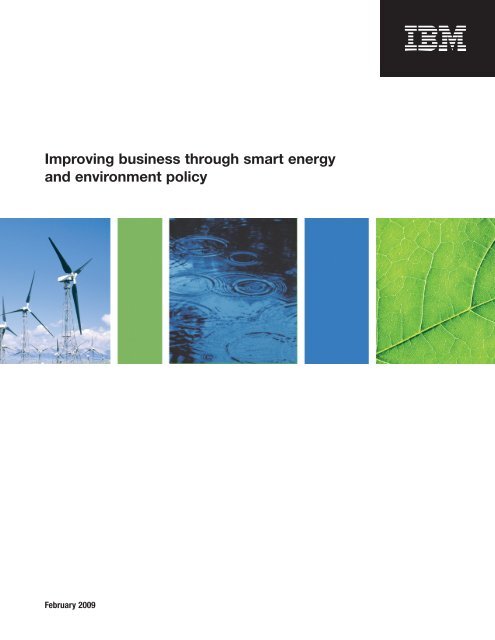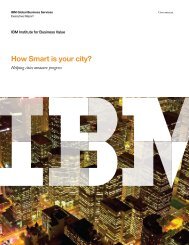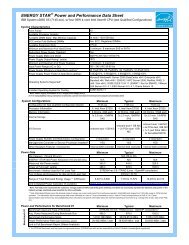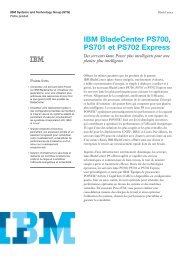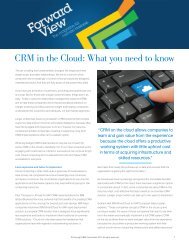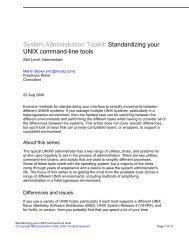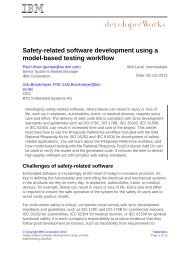Improving business through smart energy and environment ... - IBM
Improving business through smart energy and environment ... - IBM
Improving business through smart energy and environment ... - IBM
Create successful ePaper yourself
Turn your PDF publications into a flip-book with our unique Google optimized e-Paper software.
<strong>Improving</strong> <strong>business</strong> <strong>through</strong> <strong>smart</strong> <strong>energy</strong><br />
<strong>and</strong> <strong>environment</strong> policy<br />
February 2009
February 2009<br />
<strong>Improving</strong> <strong>business</strong> <strong>through</strong> <strong>smart</strong> <strong>energy</strong><br />
<strong>and</strong> <strong>environment</strong> policy<br />
Businesses <strong>and</strong> public entities today face increasing pressure to develop policies that<br />
are both good for the planet <strong>and</strong> good for <strong>business</strong>. A framework developed by<br />
<strong>IBM</strong> offers <strong>business</strong>es <strong>and</strong> other organizations a comprehensive approach to <strong>energy</strong><br />
<strong>and</strong> <strong>environment</strong>al issues. The framework helps identify <strong>and</strong> prioritize <strong>environment</strong>al<br />
efforts by breaking down problems <strong>and</strong> opportunities into seven distinct <strong>business</strong><br />
areas, which can then be segmented into manageable projects.<br />
The pressure to “go green”<br />
As global warming heats up the planet, as the price of<br />
gas <strong>and</strong> electricity soars, as a global water shortage<br />
looms, the world has begun to underst<strong>and</strong> the need for<br />
<strong>energy</strong> conservation <strong>and</strong> <strong>environment</strong>al stewardship. This<br />
<strong>environment</strong>al concern has now hit the corporate mainstream.<br />
Companies are operating in a new regulatory <strong>environment</strong>,<br />
one that sets more stringent controls over <strong>energy</strong><br />
<strong>and</strong> water consumption, greenhouse gas emissions, the<br />
use of hazardous substances <strong>and</strong> the disposal of both<br />
st<strong>and</strong>ard <strong>and</strong> hazardous waste. Many <strong>business</strong>es find their<br />
stakeholders—investors, employees <strong>and</strong> customers—<br />
dem<strong>and</strong>ing corporate <strong>environment</strong>al responsibility.<br />
Additional pressure comes from the media <strong>and</strong> <strong>environment</strong>al<br />
advocacy groups.<br />
Environmental opportunities <strong>and</strong> challenges<br />
Executives interviewed for the <strong>IBM</strong> 2008 Global CEO<br />
Study report that their concern about <strong>environment</strong>al<br />
issues has doubled over the past four years, a concern<br />
that is filtering to CIOs <strong>and</strong> line of <strong>business</strong> leaders. These<br />
professionals are now being asked to quantify <strong>and</strong> reduce<br />
corporate <strong>energy</strong> use <strong>and</strong> <strong>environment</strong>al footprints, meet<br />
regulatory requirements related to the reduction of greenhouse<br />
gases, <strong>and</strong> modify IT departments to drive more<br />
<strong>energy</strong>-efficient operations.<br />
These activities are not merely <strong>environment</strong>ally responsible:<br />
they can also drive <strong>business</strong> opportunity. According to the<br />
Global CEO Study, chief executives believe that <strong>energy</strong><br />
<strong>and</strong> <strong>environment</strong>al activities can help differentiate their<br />
br<strong>and</strong>s <strong>and</strong> burnish the reputation of their products <strong>and</strong><br />
services. Enhanced br<strong>and</strong> image can deliver market permission<br />
(allowing companies to enter new markets where<br />
<strong>environment</strong>al concerns may be paramount) <strong>and</strong> drive<br />
customer loyalty.<br />
But developing a <strong>smart</strong> <strong>energy</strong> <strong>and</strong> <strong>environment</strong>al policy is<br />
a complicated process. That’s why many companies have<br />
yet to develop any type of comprehensive policy. Those<br />
entities that do strive to craft overall <strong>energy</strong> <strong>and</strong> <strong>environment</strong>al<br />
stewardship plans often take siloed approaches to<br />
the issue. This means they concentrate on one or two<br />
specific problems without determining how <strong>business</strong> activities—overall<br />
operations, product lifecycle management, IT,<br />
property management <strong>and</strong> other factors—interrelate.<br />
An <strong>energy</strong> <strong>and</strong> <strong>environment</strong> framework<br />
<strong>IBM</strong> has developed a comprehensive approach to assisting<br />
clients with <strong>energy</strong> <strong>and</strong> <strong>environment</strong>al issues. This<br />
framework helps identify <strong>and</strong> prioritize <strong>environment</strong>al<br />
efforts by illustrating how problems <strong>and</strong> opportunities can
e broken down into distinct areas <strong>and</strong> then segmented<br />
into manageable projects. These projects can be joined to<br />
form a cross-organizational program for managing <strong>energy</strong><br />
<strong>and</strong> <strong>environment</strong>al issues.<br />
The framework consists of the following seven <strong>business</strong><br />
issues:<br />
● Strategy: The creation of an enterprisewide <strong>energy</strong> <strong>and</strong><br />
<strong>environment</strong> strategy can help companies address<br />
“green” issues.<br />
● People: Work behaviors—especially commuting <strong>and</strong><br />
<strong>business</strong>-travel behaviors—form a large part of an<br />
individual’s carbon footprint. Companies can reduce<br />
commuting <strong>and</strong> traveling <strong>through</strong> the use of online collaboration<br />
tools. Policies that reduce employee travel<br />
<strong>and</strong> commuting time are becoming increasingly important<br />
in attracting <strong>and</strong> keeping top talent.<br />
● Information: As regulations <strong>and</strong> reporting requirements<br />
compound, collecting, measuring <strong>and</strong> acting on the right<br />
information will be critical to an organization’s ability<br />
to make complicated trade-offs between <strong>business</strong><br />
alternatives.<br />
● Product: Companies can design products in a manner<br />
that reduces <strong>environment</strong>al impact. For example,<br />
streamlining of product development <strong>and</strong> manufacturing<br />
means less waste created <strong>and</strong> less <strong>energy</strong> consumed.<br />
● Information technology: IT is putting increasing levels<br />
of stress on power <strong>and</strong> cooling infrastructures. A thorough<br />
underst<strong>and</strong>ing of IT <strong>energy</strong> consumption, operations<br />
<strong>and</strong> constraints is the foundation for improvement.<br />
From this foundation, companies can devise strategies<br />
to help them improve IT efficiency <strong>and</strong> resiliency.<br />
● Property: Companies need to reduce the cost <strong>and</strong><br />
greenhouse gas emissions of their physical assets.<br />
The process starts with determining <strong>and</strong> managing the<br />
<strong>environment</strong>al impact of physical assets <strong>and</strong> properly<br />
maintaining all property for <strong>energy</strong>-efficient operations<br />
<strong>and</strong> reduced <strong>environment</strong>al impact.<br />
● Business operations: Corporations need to transform<br />
<strong>business</strong> processes to reduce <strong>environment</strong>al impact for<br />
operations end to end. Consider <strong>energy</strong> or water consumption,<br />
as a start. Underst<strong>and</strong>ing <strong>and</strong> controlling<br />
these costs can only be achieved once a company<br />
measures its existing use <strong>and</strong> compares it against<br />
conservation benchmarks. Through the use of “<strong>smart</strong><br />
systems,” dramatic efficiency improvement can take<br />
place.<br />
When leveraged appropriately, “green” strategy, innovations,<br />
solutions <strong>and</strong> services can constitute a competitive<br />
edge for enterprise <strong>and</strong> for industries—making it possible<br />
to take care of <strong>business</strong> while taking care of the planet.<br />
For more information<br />
To learn how <strong>IBM</strong> is working with organizations around the<br />
world to help them create “green” <strong>business</strong>es, contact<br />
your <strong>IBM</strong> marketing representative or <strong>IBM</strong> Business<br />
Partner, or visit the following Web sites:<br />
● ibm.com/cio<br />
● ibm.com/green
<strong>Improving</strong> <strong>business</strong> <strong>through</strong> <strong>smart</strong> <strong>energy</strong> <strong>and</strong> <strong>environment</strong> policy<br />
Contents<br />
4 The pressure to “go green”<br />
6 Environmental opportunities<br />
<strong>and</strong> challenges<br />
9 Developing <strong>environment</strong>al<br />
policies <strong>and</strong> programs<br />
10 An <strong>energy</strong> <strong>and</strong> <strong>environment</strong><br />
framework<br />
14 Leading <strong>through</strong> example<br />
17 How <strong>IBM</strong> can help<br />
19 About the author<br />
20 For more information<br />
The pressure to “go green”<br />
As global warming heats up the planet, as the price of gas <strong>and</strong> electricity<br />
soars, as a world water shortage looms, everyone from regulators to the media<br />
has started taking <strong>environment</strong>al issues seriously. They call upon individuals<br />
<strong>and</strong> <strong>business</strong>es to do the same. The need to “go green” has reached the corporate<br />
mainstream.<br />
Companies today operate in a new regulatory <strong>environment</strong>, one that sets more<br />
stringent controls over <strong>energy</strong> <strong>and</strong> water consumption, greenhouse gas emissions,<br />
the use of hazardous substances, <strong>and</strong> the disposal of both hazardous<br />
<strong>and</strong> st<strong>and</strong>ard waste. World governments explore <strong>and</strong> establish m<strong>and</strong>atory<br />
<strong>energy</strong> efficiency programs to reduce power consumption. Environmental<br />
advocacy groups track companies for <strong>environment</strong>al performance <strong>and</strong> quickly<br />
uncover enterprises that “greenwash” themselves without any credible documentation<br />
of the veracity of their claims.<br />
Business executives must also cope with stakeholder pressure to “go green.”<br />
Investors have begun to differentiate between corporate stocks that just make<br />
money <strong>and</strong> those that both make money <strong>and</strong> maintain strong <strong>environment</strong>al<br />
policies. (Witness the rise in “green” investment funds.) In regions of the world<br />
where employer need outstrips the talent pool, more <strong>and</strong> more potential<br />
employees are choosing to work for companies that—along with offering<br />
appropriate compensation packages—have a strong sense of <strong>environment</strong>al<br />
stewardship <strong>and</strong> overall corporate social responsibility.<br />
4
<strong>Improving</strong> <strong>business</strong> <strong>through</strong> <strong>smart</strong> <strong>energy</strong> <strong>and</strong> <strong>environment</strong> policy<br />
“The CIO must proactively<br />
work to identify <strong>and</strong> promote<br />
both existing <strong>and</strong> emerging<br />
technologies to address green<br />
issues outside the data center.<br />
The aggressive application of<br />
information technology <strong>and</strong><br />
software is key to achieving<br />
more cost-effective <strong>and</strong><br />
<strong>energy</strong>-efficient organizations.”<br />
— Rick Ptak,<br />
Ptak, Noel & Associates<br />
Consumers increasingly make buying decisions based on a vendor’s <strong>environment</strong>al<br />
credentials. According to the <strong>IBM</strong> study Attaining Sustainable Growth <strong>through</strong><br />
Corporate Social Responsibility (CSR), CEOs, CIOs <strong>and</strong> line-of-<strong>business</strong> executives<br />
generally agree that customer expectations for corporate social responsibility<br />
are increasing. 1 (The <strong>environment</strong> is an obvious touchstone: climate change has<br />
become a call to action for many of the world’s consumers.) What’s more,<br />
75 percent of the roughly 1,100 chief executive officers <strong>and</strong> public sector leaders<br />
surveyed for the 2008 <strong>IBM</strong> Global CEO Study say that the number of advocacy<br />
groups following <strong>and</strong> reporting on their corporate social responsibility-related<br />
activities has increased over the past three years. 2<br />
Governments themselves are subject to pressure to develop <strong>and</strong> implement<br />
<strong>smart</strong> <strong>environment</strong> <strong>and</strong> <strong>energy</strong> policies. While public bodies are exhorting their<br />
citizenries to “go green,” many of these same citizens individually <strong>and</strong> collectively<br />
now expect their governments to mitigate their impact on the <strong>environment</strong>.<br />
Moreover, since government actions are so visible, their ability to set positive<br />
examples may enhance their credibility in regulating <strong>and</strong> pressuring organizations<br />
under their jurisdictions.<br />
While the global financial crisis may divert some of our attention from issues of<br />
corporate social responsibility—such as <strong>energy</strong> use <strong>and</strong> <strong>environment</strong>al stewardship—a<br />
comprehensive policy to increase <strong>energy</strong> efficiency <strong>and</strong> reduce materials<br />
<strong>and</strong> waste continues to provide immediate opportunities for cost savings, profit<br />
improvement, <strong>and</strong> talent attraction <strong>and</strong> management. It is interesting to note that<br />
both crises direct our attention to the issues of trust <strong>and</strong> integrity, helping to<br />
demonstrate the growing realization of our financial interconnectedness as well as<br />
our <strong>environment</strong>al interconnectedness.<br />
5
<strong>Improving</strong> <strong>business</strong> <strong>through</strong> <strong>smart</strong> <strong>energy</strong> <strong>and</strong> <strong>environment</strong> policy<br />
Environmental opportunities <strong>and</strong> challenges<br />
No wonder that <strong>environment</strong> <strong>and</strong> <strong>energy</strong> policies top many executives’ to-do<br />
lists. The Global CEO Study reports CEO concern about <strong>environment</strong>al issues<br />
has doubled over the past four years. As Figure 1 shows, the Asia-Pacific region<br />
has seen the most dramatic increase, with CEO attention to <strong>energy</strong> <strong>and</strong> <strong>environment</strong><br />
issues nearly tripling since 2004.<br />
Figure 1. CEOs in each geography studied are increasingly finding <strong>environment</strong>al factors to be a top<br />
concern—<strong>and</strong> driver of change.<br />
While <strong>environment</strong>al concerns may start with the CEO, they filter to CIOs <strong>and</strong><br />
line-of-<strong>business</strong> leaders who are being asked to quantify <strong>and</strong> reduce corporate<br />
<strong>energy</strong> use <strong>and</strong> <strong>environment</strong>al footprints, streamline supply chains, meet regulatory<br />
requirements related to the reduction of greenhouse gases, <strong>and</strong> modify IT<br />
departments to drive more <strong>energy</strong>-efficient operations. These activities are not<br />
merely <strong>environment</strong>ally responsible: they can also drive cost savings—another<br />
universal corporate m<strong>and</strong>ate. For example, according to <strong>IBM</strong> projections,<br />
$1 in <strong>energy</strong> savings can often drive an additional $6 to $8 in operational savings.<br />
In addition, “green” policies can provide competitive differentiation.<br />
6
<strong>Improving</strong> <strong>business</strong> <strong>through</strong> <strong>smart</strong> <strong>energy</strong> <strong>and</strong> <strong>environment</strong> policy<br />
The <strong>business</strong> benefit of increasing <strong>energy</strong> <strong>and</strong> material effectiveness, along with<br />
increasing regulatory <strong>environment</strong>s <strong>and</strong> pressure levied by the media, <strong>environment</strong>al<br />
advocacy groups, consumers <strong>and</strong> stakeholders, have made it necessary<br />
for today’s companies to rethink their <strong>energy</strong> <strong>and</strong> <strong>environment</strong> policies.<br />
Corporations face significant challenges in developing <strong>and</strong> implementing policies<br />
meant to conserve <strong>energy</strong> <strong>and</strong> protect the <strong>environment</strong>. But executives believe<br />
that <strong>energy</strong> conservation <strong>and</strong> <strong>environment</strong>al stewardship also present significant<br />
opportunities. (See “Green is the new black.”) According to the <strong>IBM</strong> Global CEO<br />
Study, CEOs believe that <strong>energy</strong> <strong>and</strong> <strong>environment</strong>al activities can help differentiate<br />
their br<strong>and</strong>s <strong>and</strong> burnish the reputation of their products <strong>and</strong> services.<br />
Enhanced br<strong>and</strong> image can deliver market permission <strong>and</strong> drive customer <strong>and</strong><br />
employee loyalty. Because of this, as Figure 2 shows, CEOs plan to increase their<br />
investment in corporate social responsibility by 25 percent over the next three<br />
years. (Corporate social responsibility is defined, for the purposes of this paper,<br />
as the actions taken by companies that choose to manage their <strong>business</strong>es for<br />
positive impact on society. This is accomplished <strong>through</strong> economic, <strong>environment</strong>al<br />
<strong>and</strong> social activities.)<br />
Figure 2. CEOS are generally positive about the impact of rising corporate social responsibility<br />
expectations <strong>and</strong> they are increasing their investments in this area.<br />
7
<strong>Improving</strong> <strong>business</strong> <strong>through</strong> <strong>smart</strong> <strong>energy</strong> <strong>and</strong> <strong>environment</strong> policy<br />
But “going green” isn’t easy. That’s why many companies have yet to develop<br />
any type of comprehensive policy. Those entities that do strive to craft overall<br />
<strong>energy</strong> <strong>and</strong> <strong>environment</strong>al stewardship plans often take siloed approaches to the<br />
issue. This means they concentrate on one or two specific problems without<br />
determining how <strong>business</strong> activities—overall operations, product lifecycle management,<br />
IT, property management, employee commuting practices <strong>and</strong> other<br />
factors—interrelate.<br />
Companies wishing to develop <strong>and</strong> implement <strong>smart</strong> <strong>environment</strong>al, <strong>energy</strong> <strong>and</strong><br />
sustainability practices are often stymied by issues such as:<br />
● Lack of a coherent, overarching <strong>energy</strong> <strong>and</strong> <strong>environment</strong> strategy<br />
● Lack of actionable data <strong>and</strong> the inability first to measure <strong>energy</strong> use <strong>and</strong><br />
greenhouse gas emissions <strong>and</strong> then to determine how to reduce them<br />
● Lack of underst<strong>and</strong>ing of the steps that must be taken to enter new<br />
markets where issues related to <strong>energy</strong>, <strong>environment</strong> <strong>and</strong> sustainability may<br />
be paramount<br />
● Immature supply chains that don’t allow global consistency in the adherence<br />
to <strong>environment</strong>al policies<br />
● Product engineering, manufacturing <strong>and</strong> disposal practices that are incompatible<br />
with <strong>environment</strong>al stewardship<br />
● Travel <strong>and</strong> commuting policies that fail to consider <strong>energy</strong> use <strong>and</strong> environ-<br />
mental impact<br />
8
<strong>Improving</strong> <strong>business</strong> <strong>through</strong> <strong>smart</strong> <strong>energy</strong> <strong>and</strong> <strong>environment</strong> policy<br />
Electricity customers<br />
like control<br />
As part of the U.S. Department of<br />
Energy’s GridWise program, the<br />
Pacific Northwest National<br />
Laboratory wanted to ensure the<br />
health of the region’s electrical<br />
grid—especially in times of heavy<br />
use. To accomplish this, the<br />
Laboratory planned to manage<br />
electrical dem<strong>and</strong> <strong>through</strong> a combination<br />
of intelligent technology <strong>and</strong><br />
financial incentives.<br />
The Laboratory set up two parallel<br />
studies to test its ideas. In one, the<br />
organization created a virtual marketplace<br />
that allowed consumers to<br />
trade flexibility in usage for lower<br />
costs. The second study tested<br />
“<strong>smart</strong>” appliances that could<br />
sense <strong>and</strong> respond to stress on the<br />
electric grid by temporarily curtailing<br />
electricity use.<br />
The studies found that people far<br />
preferred the virtual marketplace—<br />
they wanted to control <strong>energy</strong> use<br />
themselves, rather than having a<br />
third party decide when to limit<br />
consumption. People trading flexibility<br />
in usage for lower <strong>energy</strong><br />
costs saw, on average, a 10 percent<br />
reduction in their electric bills.<br />
Developing <strong>environment</strong>al policies <strong>and</strong> programs<br />
Leaders in boardrooms, public bodies, regions <strong>and</strong> industries now face growing<br />
pressures to become more sensitive to their organizations’ <strong>energy</strong> consumption<br />
<strong>and</strong> <strong>environment</strong>al impact. Enterprises look across their organizations, trying to<br />
address these issues by improving processes. Concurrently, <strong>business</strong> executives<br />
are keenly aware that the process of becoming “green” must aid <strong>business</strong> as well<br />
as the <strong>environment</strong>.<br />
To develop policies that are both good for the planet <strong>and</strong> good for <strong>business</strong>, corporate<br />
leaders must consider questions such as:<br />
● Are all aspects of my <strong>business</strong>, including operations, IT <strong>and</strong> product lifecycle<br />
management, efficient <strong>and</strong> protective of the <strong>environment</strong>?<br />
● As part of our overall strategy to increase <strong>business</strong> efficiency, are we<br />
considering that <strong>environment</strong>al stewardship <strong>and</strong> <strong>energy</strong> consumption are<br />
new <strong>business</strong> barometers?<br />
● Does my organization maintain a public commitment to meaningful <strong>and</strong><br />
achievable goals, with transparency in reporting corporate progress in meeting<br />
those goals?<br />
● Are we taking a leadership position in driving <strong>energy</strong> conservation <strong>and</strong> <strong>environment</strong>al<br />
stewardship <strong>through</strong> the value chain <strong>and</strong> across our industry?<br />
● Do we have a strategy that supports reducing costs, lowering complexity,<br />
<strong>and</strong> increasing operating <strong>and</strong> <strong>energy</strong> efficiency?<br />
● Are we looking for ways to improve IT operations to generate more computing<br />
performance without increasing power consumption?<br />
● Are we experiencing social <strong>and</strong> regulatory pressure <strong>and</strong> responding with<br />
verifiable <strong>energy</strong> conservation initiatives that proactively address <strong>energy</strong> <strong>and</strong><br />
climate challenges?<br />
● Are we pursuing the development of <strong>energy</strong> <strong>and</strong> <strong>environment</strong>al strategies<br />
<strong>and</strong> policies to improve <strong>business</strong> <strong>and</strong> br<strong>and</strong> position?<br />
9
<strong>Improving</strong> <strong>business</strong> <strong>through</strong> <strong>smart</strong> <strong>energy</strong> <strong>and</strong> <strong>environment</strong> policy<br />
An <strong>energy</strong> <strong>and</strong> <strong>environment</strong> framework<br />
Each of these issues can seem complicated when considered individually, perhaps<br />
overwhelming when viewed as an interrelated group. Underst<strong>and</strong>ing this,<br />
<strong>IBM</strong> has developed a comprehensive approach to assisting clients with <strong>energy</strong><br />
<strong>and</strong> <strong>environment</strong>al issues.<br />
This framework helps identify <strong>and</strong> prioritize <strong>environment</strong>al efforts by illustrating<br />
how problems <strong>and</strong> opportunities can be broken down into distinct areas <strong>and</strong> then<br />
segmented into manageable projects to be addressed. These projects can be<br />
joined to form a cross-organizational program managing <strong>energy</strong> <strong>and</strong> <strong>environment</strong>al<br />
issues.<br />
This framework addresses the needs of various executives in developing <strong>and</strong><br />
implementing <strong>energy</strong> <strong>and</strong> <strong>environment</strong> strategies: the CEO’s need to respond to<br />
customer, government <strong>and</strong> employee expectations; the CFO’s need to deal with<br />
changing cost dynamics for <strong>energy</strong>; COO’s <strong>and</strong> line-of-<strong>business</strong> needs to design<br />
<strong>and</strong> implement new processes; <strong>and</strong> the CIO’s need to increase computing power<br />
while managing <strong>energy</strong> consumption.<br />
The framework presented below has grown organically from <strong>IBM</strong>’s cross-industry<br />
expertise, innovative research, <strong>and</strong> experience helping enterprises to address<br />
<strong>energy</strong> <strong>and</strong> <strong>environment</strong>al challenges. <strong>IBM</strong> called upon its unique ability to bring<br />
technological innovations, <strong>business</strong> process transformation <strong>and</strong> industry expertise<br />
together into a comprehensive set of solutions <strong>and</strong> services.<br />
10
<strong>Improving</strong> <strong>business</strong> <strong>through</strong> <strong>smart</strong> <strong>energy</strong> <strong>and</strong> <strong>environment</strong> policy<br />
As delineated in Figure 3, seven <strong>business</strong> components are addressed in the<br />
framework: strategy, people, information, product, IT, property, <strong>and</strong> <strong>business</strong><br />
operations. These components are common to virtually any enterprise or organization<br />
dealing with <strong>energy</strong> <strong>and</strong> <strong>environment</strong> issues. Encircling these are the<br />
<strong>IBM</strong> points of credibility in uniquely addressing client needs.<br />
Figure 3: This <strong>energy</strong> <strong>and</strong> <strong>environment</strong> framework addresses organizational components commonly<br />
in place.<br />
11
<strong>Improving</strong> <strong>business</strong> <strong>through</strong> <strong>smart</strong> <strong>energy</strong> <strong>and</strong> <strong>environment</strong> policy<br />
Strategy<br />
The creation of an enterprisewide <strong>energy</strong> <strong>and</strong> <strong>environment</strong> strategy as part of an<br />
overarching corporate social responsibility plan can help companies address<br />
“green” issues, resulting in improved financial <strong>and</strong> <strong>environment</strong>al outcomes.<br />
Issues to be considered include the alignment of a company’s <strong>environment</strong>al<br />
strategy into an overall <strong>business</strong> strategy <strong>and</strong> how <strong>environment</strong>al values may be<br />
translated into an improved br<strong>and</strong> image.<br />
People<br />
The impact of employee behaviors <strong>and</strong> policies on the <strong>environment</strong> is significant.<br />
Commute time <strong>and</strong> <strong>business</strong> travel form a large part of an individual’s carbon<br />
footprint. The use of online collaboration tools <strong>and</strong> policies that support reduction<br />
in commuting <strong>and</strong> traveling can also have an impact on costs. Finally, companies<br />
are discovering that their <strong>environment</strong>al policies <strong>and</strong> practices can impact their<br />
ability to attract <strong>and</strong> retain top talent.<br />
Information<br />
As regulations <strong>and</strong> reporting requirements compound, companies <strong>and</strong> organizations<br />
will need to make increasingly complicated decisions on the trade-offs<br />
between alternative <strong>business</strong> processes, manufacturing systems, transportation<br />
methods <strong>and</strong> supply sources. Knowing what to measure, collecting reliable information<br />
<strong>and</strong> effectively measuring <strong>and</strong> acting on it will be critical. These decisions<br />
will require even more granular information <strong>and</strong> more sophisticated decision support.<br />
Optimized information collection, analysis, tiering <strong>and</strong> storage will help with<br />
speeding access to information, addressing regulatory m<strong>and</strong>ates <strong>and</strong> reducing<br />
the cost of reporting.<br />
12
<strong>Improving</strong> <strong>business</strong> <strong>through</strong> <strong>smart</strong> <strong>energy</strong> <strong>and</strong> <strong>environment</strong> policy<br />
“A strategic, top-down<br />
organizational strategic<br />
transformation must take place<br />
<strong>through</strong>out the organization.<br />
Future sustainable<br />
organizations will have put in<br />
place a multifaceted, rigorous,<br />
<strong>and</strong> interconnected strategy<br />
directly linked to overall<br />
company strategy <strong>and</strong> goals.”<br />
— Crossing the Great<br />
Divide: Sustainability as<br />
Corporate Strategy,<br />
Stephen Stokes, AMR<br />
September 16, 2008<br />
Product<br />
As companies begin to underst<strong>and</strong> the <strong>environment</strong>al impact of their products or<br />
services across the entire product lifecycle, they can design products in a manner<br />
that has a lower <strong>environment</strong>al impact. Streamlining of product development <strong>and</strong><br />
manufacturing also means less material used, less waste created <strong>and</strong> less <strong>energy</strong><br />
consumed. Concurrently, an examination of the product or service lifecycle often<br />
helps <strong>business</strong>es find <strong>and</strong> exploit market opportunities. Finally, the need to<br />
reduce <strong>energy</strong> consumption is driving an increase in the <strong>energy</strong>-management<br />
intelligence built into certain products.<br />
Information technology<br />
Information technology is putting increasing levels of stress on power <strong>and</strong> cooling<br />
infrastructures. According to <strong>IBM</strong> estimates, IT kilowatt-hour usage has increased<br />
fivefold in the past five years. This IT-related <strong>energy</strong> use contributes to the establishment’s<br />
greenhouse gas emissions. CIOs <strong>and</strong> IT managers view this situation<br />
as an economic <strong>and</strong> <strong>environment</strong>al crisis.<br />
Corporations need IT <strong>energy</strong> efficiency strategies designed to help them focus<br />
their efforts. A thorough underst<strong>and</strong>ing of IT <strong>energy</strong> consumption, operations <strong>and</strong><br />
constraints is the foundation for improvement. From this foundation, companies<br />
can devise strategies to help them improve IT efficiency <strong>and</strong> resiliency, address<br />
emissions, reduce <strong>energy</strong> costs <strong>and</strong> measure their success against <strong>business</strong><br />
goals.<br />
13
<strong>Improving</strong> <strong>business</strong> <strong>through</strong> <strong>smart</strong> <strong>energy</strong> <strong>and</strong> <strong>environment</strong> policy<br />
Property<br />
Companies need to reduce the cost <strong>and</strong> greenhouse gas emissions of their<br />
physical assets—from office buildings to truck fleets. The process starts with<br />
determining <strong>and</strong> managing the <strong>environment</strong>al impact of physical assets <strong>and</strong> properly<br />
maintaining all property for <strong>energy</strong>-efficient operations <strong>and</strong> reduced <strong>environment</strong>al<br />
impact. Through improved maintenance <strong>and</strong> <strong>through</strong> improved tracking,<br />
deployment, location, <strong>and</strong> management of facilities <strong>and</strong> properties, reductions in<br />
<strong>environment</strong>al impact can be achieved.<br />
Business operations<br />
Corporations need to transform <strong>business</strong> processes to reduce <strong>environment</strong>al<br />
impact for operations end-to-end. Consider <strong>energy</strong> or water consumption, as a<br />
start. Underst<strong>and</strong>ing <strong>and</strong> controlling these costs can only be achieved once a<br />
company measures its existing use <strong>and</strong> compares it against conservation benchmarks.<br />
Through the use of “<strong>smart</strong>” systems, dramatic efficiency improvement can<br />
take place. Any transformation plan put into place must be communicated to key<br />
stakeholders.<br />
Leading <strong>through</strong> example<br />
Companies seeking to “go green” rightly look to partner with <strong>environment</strong>ally<br />
responsible <strong>business</strong>es to procure technological products, services <strong>and</strong> solutions.<br />
In addition, companies need to partner with an enterprise known for its expertise<br />
in <strong>energy</strong> conservation, <strong>energy</strong> efficiency <strong>and</strong> <strong>environment</strong>al stewardship. <strong>IBM</strong>’s<br />
<strong>environment</strong>al policy (which was first issued in 1971), along with its supporting<br />
programs <strong>and</strong> results, demonstrate the company’s leadership <strong>and</strong> expertise in<br />
these areas. For example, between 1990 <strong>and</strong> 2007, <strong>IBM</strong>’s annual <strong>energy</strong> conservation<br />
actions saved 4.6 billion kilowatt hours of electricity consumption. This<br />
avoided nearly 3.1 million metric tons of CO2 emissions (equal to 45 percent of<br />
the company’s global CO2 emissions) <strong>and</strong> saved more than $310 million in<br />
<strong>energy</strong> expense. <strong>IBM</strong> has also voluntarily reported its <strong>environment</strong>al performance<br />
annually for the last 17 years.<br />
14
<strong>Improving</strong> <strong>business</strong> <strong>through</strong> <strong>smart</strong> <strong>energy</strong> <strong>and</strong> <strong>environment</strong> policy<br />
New data center saves power,<br />
aids corporate<br />
expansion<br />
The kika/Leiner Group, a top-five<br />
European furniture retailer, was<br />
undergoing a <strong>business</strong> expansion<br />
across Europe <strong>and</strong> the Middle East.<br />
Corporate executives worried that<br />
the company’s aging data center<br />
would be unable to support this<br />
growth. The retailer wanted a new<br />
data center, one that could support<br />
the expansion while providing<br />
<strong>energy</strong> efficiency <strong>and</strong> a compact<br />
footprint.<br />
A new-generation data center met<br />
the company’s <strong>business</strong> goals for<br />
both <strong>energy</strong> consumption <strong>and</strong><br />
improved data center operations.<br />
The data center reduced power<br />
consumption by up to 40 percent. It<br />
also offered improved security <strong>and</strong><br />
reliability, <strong>and</strong> a lower total cost of<br />
ownership—all of which proved<br />
important in supporting<br />
kika/Leiner’s expansion plans.<br />
Consider just three <strong>IBM</strong> recent initiatives:<br />
<strong>IBM</strong> Project Big Green: Announced in May 2007, Project Big Green is a<br />
$1 billion initiative to dramatically reduce <strong>energy</strong> use by <strong>IBM</strong> <strong>and</strong> its clients. The<br />
initiative includes new <strong>energy</strong>-efficient <strong>IBM</strong> products <strong>and</strong> services <strong>and</strong> a five-step<br />
approach to <strong>energy</strong> efficiency in the data center. This approach can sharply<br />
reduce data center <strong>energy</strong> consumption, transforming companies’ technology<br />
infrastructures <strong>and</strong> providing <strong>energy</strong> savings of up to 42 percent. 3 In June 2008,<br />
Project Big Green was exp<strong>and</strong>ed to include core software offerings that enable<br />
clients to extend their <strong>energy</strong> efficiency efforts beyond the data center.<br />
Carbon Management Best Practices: <strong>IBM</strong> <strong>and</strong> the Carbon Disclosure Project<br />
have launched a research project focused on the best practices employed by<br />
companies to gather <strong>and</strong> h<strong>and</strong>le carbon dioxide-related data. The project seeks<br />
information from <strong>business</strong>es that have extensive experience in measuring <strong>and</strong><br />
managing greenhouse gas emissions. By getting insight into current actions,<br />
<strong>IBM</strong> <strong>and</strong> the Carbon Disclosure Project plan to craft a series of best practices<br />
related to CO2 management <strong>and</strong> reporting. The research will focus on proactive<br />
CO2 management programs, how the economy affects CO2 management, <strong>and</strong><br />
how well companies underst<strong>and</strong> issues surrounding greenhouse gas emissions.<br />
The Global Intelligent Utility Network Coalition: In 2007, <strong>IBM</strong> founded the<br />
Global Intelligent Utility Network Coalition, a group of utility companies working<br />
with <strong>IBM</strong> to accelerate the adoption of <strong>smart</strong> grid technologies <strong>and</strong> <strong>business</strong><br />
solutions <strong>through</strong>out the world. An intelligent utility network fundamentally transforms<br />
the way power is generated, distributed <strong>and</strong> used, adding intelligence<br />
<strong>through</strong>out the grid to dramatically reduce outages <strong>and</strong> faults, improve responsiveness,<br />
h<strong>and</strong>le current <strong>and</strong> future dem<strong>and</strong>, increase efficiency, <strong>and</strong> manage<br />
costs.<br />
15
<strong>Improving</strong> <strong>business</strong> <strong>through</strong> <strong>smart</strong> <strong>energy</strong> <strong>and</strong> <strong>environment</strong> policy<br />
“There are profound<br />
opportunities to benefit from<br />
changes in the industry <strong>and</strong><br />
how <strong>business</strong> models will be<br />
challenged.”<br />
— Electric utility CEO<br />
<strong>IBM</strong>’s <strong>environment</strong>al policy calls for the company to be an <strong>environment</strong>al<br />
leader in all its <strong>business</strong> activities. For example, <strong>IBM</strong> is committed to<br />
doubling its own computing capacity by 2010, without increasing power use. In<br />
house, <strong>IBM</strong> deploys data center <strong>energy</strong>-management techniques to diagnose,<br />
measure, manage, virtualize, cool <strong>and</strong> build servers. The company has a global<br />
<strong>energy</strong> program <strong>and</strong> objectives by which its physical properties are built <strong>and</strong><br />
managed. In its <strong>business</strong> operations, <strong>IBM</strong> has programs to conserve resources,<br />
prevent pollution, evaluate suppliers for their <strong>environment</strong>al stewardship, <strong>and</strong><br />
develop manufacturing processes that are protective of the <strong>environment</strong>. The<br />
company has a host of video conference <strong>and</strong> collaboration tools <strong>and</strong> work-life<br />
balance programs that enable its employees to reduce travel <strong>and</strong> related CO2<br />
emissions. <strong>IBM</strong>’s longst<strong>and</strong>ing product stewardship program has enabled the<br />
company to develop <strong>and</strong> offer products with a wide range of <strong>environment</strong>al attributes,<br />
ranging from <strong>energy</strong> efficiency to the use of <strong>environment</strong>ally preferable<br />
materials <strong>and</strong> finishes.<br />
The company also excels in end-of-life IT product management <strong>and</strong> recycling.<br />
Over the past four years, <strong>IBM</strong>’s Global Asset Recovery operations have collected<br />
<strong>and</strong> reused more than 4.6 million machines while limiting the amount of product<br />
waste these operations have sent to l<strong>and</strong>fills to less than 1 percent of the total<br />
waste they processed. What’s more, <strong>IBM</strong> Research has been instrumental in supporting<br />
<strong>IBM</strong>’s <strong>environment</strong>al efforts. It has invented numerous <strong>environment</strong>ally<br />
<strong>smart</strong> products beyond the scope of its usual <strong>business</strong>. For example, bringing<br />
unique skills from its vast experience in semiconductors <strong>and</strong> nanotechnology to<br />
the important field of alternative <strong>energy</strong> research, <strong>IBM</strong> Research has made<br />
advances in photovoltaics technology. These types of advances could deliver up<br />
to five times the efficiency of current solar farm technology.<br />
16
<strong>Improving</strong> <strong>business</strong> <strong>through</strong> <strong>smart</strong> <strong>energy</strong> <strong>and</strong> <strong>environment</strong> policy<br />
“<strong>IBM</strong> has taken a lead in the<br />
area of carbon management,<br />
particularly across government<br />
organizations. Its long history<br />
of running consulting projects,<br />
planning <strong>and</strong> supporting the<br />
delivery of solutions <strong>and</strong> its<br />
ability to work across areas<br />
such as estates management,<br />
procurement <strong>and</strong> IT, made it<br />
the perfect choice to help us<br />
meet our challenging target.”<br />
— David Young,<br />
Executive Director of<br />
Strategy <strong>and</strong> Performance,<br />
Natural Engl<strong>and</strong><br />
How <strong>IBM</strong> can help<br />
<strong>IBM</strong>’s research, innovation <strong>and</strong> experience in the fields of <strong>energy</strong> conservation<br />
<strong>and</strong> <strong>environment</strong>al stewardship, coupled with demonstrated <strong>environment</strong>al leadership<br />
both in house <strong>and</strong> in helping clients address <strong>energy</strong> <strong>and</strong> <strong>environment</strong>al<br />
issues, has created the company’s unique, overarching view of the challenges<br />
<strong>and</strong> opportunities that arise in the quest to “go green.” <strong>IBM</strong> is the leader in<br />
delivering innovative, end-to-end, results-oriented <strong>environment</strong>al solutions <strong>and</strong><br />
services to corporations, governments, institutions <strong>and</strong> entire industries.<br />
<strong>IBM</strong>’s <strong>business</strong> <strong>and</strong> industry experts have helped clients think <strong>through</strong> complex<br />
<strong>environment</strong>al issues to arrive at answers that deliver <strong>business</strong> results.<br />
<strong>IBM</strong> does this because it thinks that corporate social responsibility <strong>and</strong> <strong>environment</strong>al<br />
stewardship are among the most important issues facing the world today.<br />
<strong>IBM</strong>’s point of view is a simple one: industry <strong>and</strong> <strong>business</strong> expertise coupled with<br />
technological advances can <strong>and</strong> must address issues of <strong>environment</strong>al stewardship<br />
<strong>and</strong> <strong>energy</strong> conservation. These issues must be addressed across corporations,<br />
across industries <strong>and</strong> across geographies. Only the companies that meet<br />
these <strong>environment</strong>al challenges will thrive in an arena where “green” is not only a<br />
laudable goal, but an imperative.<br />
<strong>IBM</strong>’s industry-oriented, multi-faceted offerings can provide enterprises with a<br />
competitive advantage, one that draws on <strong>IBM</strong>’s experience <strong>and</strong> capabilities<br />
across hardware, software, industry-specific solutions, <strong>business</strong> solutions,<br />
<strong>business</strong> services <strong>and</strong> research. With decades of leadership in <strong>environment</strong>al<br />
17
<strong>Improving</strong> <strong>business</strong> <strong>through</strong> <strong>smart</strong> <strong>energy</strong> <strong>and</strong> <strong>environment</strong> policy<br />
stewardship <strong>and</strong> technology innovation, a global talent pool of unmatched <strong>business</strong><br />
<strong>and</strong> technical skills, specific industry process expertise, <strong>and</strong> a proven ability<br />
to solve complex challenges, <strong>IBM</strong> is uniquely positioned to offer clients:<br />
● A holistic approach to IT infrastructure efficiency, <strong>business</strong> process transformation,<br />
<strong>and</strong> the development of new products <strong>and</strong> services to address<br />
<strong>energy</strong> <strong>and</strong> <strong>environment</strong> issues <strong>and</strong> opportunities<br />
● Depth of experience based on nearly four decades of <strong>IBM</strong> <strong>environment</strong>al<br />
leadership <strong>and</strong> results gleaned from in-house management <strong>and</strong> from aiding<br />
thous<strong>and</strong>s of clients in making their own <strong>business</strong>es more protective of the<br />
<strong>environment</strong><br />
● Solutions <strong>and</strong> services based on <strong>IBM</strong>’s deep <strong>business</strong> <strong>and</strong> process knowledge<br />
<strong>and</strong> unmatched capabilities for technological innovation<br />
When leveraged appropriately, <strong>energy</strong> <strong>and</strong> <strong>environment</strong>al strategies, innovations,<br />
solutions <strong>and</strong> services can constitute a competitive edge for enterprises <strong>and</strong> for<br />
industries. Your <strong>business</strong> can do well while doing good.<br />
18
<strong>Improving</strong> <strong>business</strong> <strong>through</strong> <strong>smart</strong> <strong>energy</strong> <strong>and</strong> <strong>environment</strong> policy<br />
Green is the new black<br />
To meet growing corporate social responsibility expectations, British retailer<br />
Marks & Spencer has embarked on a £200-million, five-year plan (known as<br />
Plan A) that impacts almost every aspect of its operations.<br />
Through this effort, launched in 2006, the retailer—known for its clothing,<br />
home products <strong>and</strong> grocery arms—wanted to engage customers in solving<br />
“green” issues.<br />
Marks & Spencer gave customers free reusable shopping bags. The bags<br />
were deployed “for life.” (If a bag wears out, the retailer will replace it for free.)<br />
When this initiative was in its fifth week, the company began charging shoppers<br />
for plastic bags. It donated the proceeds of plastic-bag sales to <strong>environment</strong>al<br />
charities.<br />
Very quickly, customers began reevaluating their need for plastic shopping<br />
bags. The fee, though quite small, made people stop to think about their<br />
impact on the <strong>environment</strong>.<br />
But the retailer’s initiative extends far beyond the checkout line<br />
Behind Marks & Spencer’s 35,000 products sit more than 20,000 factories,<br />
farms, fisheries <strong>and</strong> forests, <strong>and</strong> an estimated 500,000 workers in the developing<br />
world. Through its recently established online supplier exchange, the<br />
company strives to simultaneously improve both efficiency <strong>and</strong> sustainability.<br />
For instance, farmers who create biogases from farm waste are now selling<br />
the retailer their green electricity along with their beef.<br />
Since launch, the expected 40 million British pounds a year cost of Plan A has<br />
plummeted to zero as M&S has found new ways of saving money from green<br />
initiatives. Now each pound invested in Plan A change is paid for by a pound<br />
saving elsewhere in the company.<br />
About the author<br />
This paper was written by Ellen Johnson. Ms. Johnson is a senior marketing<br />
manager for <strong>IBM</strong> Global Business Services. She is also part of an extended team<br />
of <strong>IBM</strong> professionals working to help clients underst<strong>and</strong> <strong>and</strong> improve their impact<br />
on the <strong>environment</strong>. Vik Ch<strong>and</strong>ra, Gail Jarrett, Christine Kinser, Diana Lyon,<br />
Christopher Spaight, Amy Stenard, Scott Stockwell, Andrew Verdesca <strong>and</strong><br />
Graham Whitney also contributed to this paper.<br />
19
For more information<br />
To learn how <strong>IBM</strong> is working with organizations around the world to help them<br />
create “green” <strong>business</strong>es, contact your <strong>IBM</strong> marketing representative or<br />
<strong>IBM</strong> Business Partner, or visit the following Web sites:<br />
● ibm.com/cio<br />
● ibm.com/green<br />
<strong>IBM</strong> Global Financing<br />
<strong>IBM</strong> Global Financing can tailor financing solutions to your specific IT needs. For<br />
more information on great rates, flexible payment plans <strong>and</strong> loans, <strong>and</strong> asset buyback<br />
<strong>and</strong> disposal, visit:<br />
ibm.com/financing<br />
© Copyright <strong>IBM</strong> Corporation 2009<br />
<strong>IBM</strong> Corporation<br />
New Orchard Road<br />
Armonk, NY 10504<br />
U.S.A.<br />
Produced in the United States of America<br />
February 2009<br />
All Rights Reserved<br />
<strong>IBM</strong>, the <strong>IBM</strong> logo <strong>and</strong> ibm.com are trademarks<br />
or registered trademarks of International<br />
Business Machines Corporation in the<br />
United States, other countries, or both. If these<br />
<strong>and</strong> other <strong>IBM</strong> trademarked terms are marked<br />
on their first occurrence in this information with a<br />
trademark symbol (® or ), these symbols indicate<br />
U.S. registered or common law trademarks<br />
owned by <strong>IBM</strong> at the time this information was<br />
published. Such trademarks may also be registered<br />
or common law trademarks in other countries.<br />
A current list of <strong>IBM</strong> trademarks is available<br />
on the Web at ”Copyright <strong>and</strong> trademark information”<br />
at ibm.com/legal/copytrade.shtml.<br />
Other product, company or service names may<br />
be trademarks or service marks of others.<br />
References in this publication to <strong>IBM</strong> products<br />
or services do not imply that <strong>IBM</strong> intends to<br />
make them available in all countries in which<br />
<strong>IBM</strong> operates.<br />
1 <strong>IBM</strong> Corporate Social Responsibility: Attaining<br />
Sustainable Growth <strong>through</strong> Corporate Social<br />
Responsibility, 2008.<br />
ibm.com/ibm/ideasfromibm/us/csr/20080401/<br />
index.shtml.<br />
2 The Enterprise of the Future: <strong>IBM</strong> Global CEO<br />
Study 2008.<br />
ibm.com/ibm/ideasfromibm/us/ceo/20080505/<br />
index.shtml.<br />
3 <strong>IBM</strong> Project Big Green, 2008.<br />
http://www-03.ibm.com/press/us/en/presskit/<br />
21440.wss.<br />
CIW03052-USEN-02


